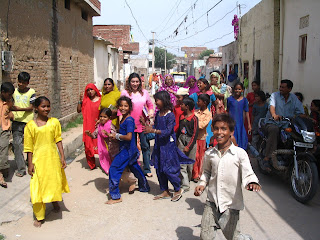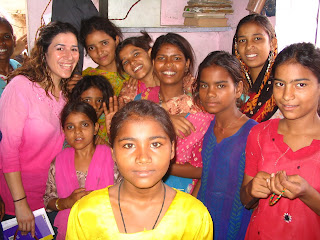
Water Jug
The following pictures are of the loan recipients themselves. We interacted with one woman in particular who I believe is the designated leader of the group (Farida Bannu). She was incredibly bright, calm and confident. Everyone seemed to like her, including the children (as you can see from the photos). She invited us to her house compound and studio/store, and gave both Maria Luisa and I bangals (photo). We tried later to pay her, and the most she would do was accept money for the cost of the materials. She said our organization is non-profit, so why should she make a profit when selling the bangals to us?

Farida Bannu and women in red

Farida’s sewing machine
The group leaders collect money from the other women before the weekly meetings with the loan officers, and have other responsibilities as well. Loans are given to groups of women, and the whole group is responsible for the money. In other words, if one woman does not pay, the other women have to pay her portion. As you can imagine, that creates a certain accountability/peer pressure, and also allows the women to form they kind of relationships that could bridge into other areas as well. For example, there are groups called ‘Self Help Groups’ (SHGs) in the humanitarian/disaster response program, and those groups are the venue through which a lot of decisions are made and information is disseminated. SHGs also helps identify and strengthen community leaders. In the case of the loan recipient group, this group could become committees for other initiatives such as sanitation, hygiene, and various public health projects. For her summer Fellowship Maria Luisa is creating a report about the program and making suggestions for continuation and modifications. One of the things that she has identified is the possibility of providing entrepreneurship and other training to the women in the groups rather than train solely on financial management.

Maria Luisa with community
A bit about Jaipur generally: It forms a triangle with Delhi and Agra (the location of the Taj Mahal), and is perhaps the most touristy of the cities. Agra (which I also just visited and will write about shortly) is also touristy because of the Taj Mahal, but it is more of a one day trip and there is enough to do in Jaipur for a number of days. There were forts and temples and a beautiful old city with some fantastic bazaars and shopping.
By fantastic shopping, I mean really good prices, if you can bargain down. There are some of the best fabrics, sarees, traditional shoes, jewelry (especially silver), and pottery famous to the region. We spent two 1-2 hour chunks looking and buying. It’s where I’ve purchased most of the gifts I’ll bring home. Shopping there is exhausting. Actually, just being there was exhausting. It was hotter than Delhi, and because it is a tourist area we were treated as tourists – people with money to be milked. As you walk along the street, people are practically pulling you into their shops. If you do go in, the merchants start unfolding their wares, pulling things off the shelf, and otherwise keeping you there even if you persistently say ‘no thank you’ over and over again. It’s surprisingly effective. After someone has spent even 1-3 minutes unfolding fabric while you protest, you feel like you owe them something for their effort. That faded as the days went on, and I was able to separate business and emotions.
We met a few really interesting merchants. One was a gentleman who was the third generation to run a spice and snack shop. He made his own tea, perfume, and regional snacks. He gave us a taste of something like a pomegranate fruit chew. There were some spices in it, one of which was cardamom, and he said it functions as a digestive. We took a photo of him in his shop (Blogpot just stopped allowing me to post photos... I'll try again later).
The other person was a potter – a man named Kripal Singh who had won many international awards for his work. The guide book said you might be told by taxi/rickshaw drivers that he has passed away and be taken to another place where they receive commission for bringing customers. As it turns out, Kripal Singh actually did pass away about two months before. The taxi r and hotel clerk told me at the same time, and when we went to the studio (located in their residence), we met with his daughter who also said he’d passed away and she had taken over the workshop. His daughter, Kumud, is a potter as well, and I ended up buying a plate that she made. Some of your gifts will come from there, and if you visit our apartment next year, we’ll serve you water in ceramic cups while you admire the flowers in our ceramic vase.
I spent a good deal of time talking with Kumud. The pottery is known as the ‘blue pottery’ of Jaipur, and it looked very familiar, very much like a plate that used to hang on my grandma’s kitchen wall. I created a story in my head that my grandma had actually been there, and I started telling the potter’s daughter about her: her travels, her long-distance friendship with an Indian man she’d met in a German art school, the plate hanging on the wall, etc. I said this is just the place my grandma would have found – an authentic, welcoming artist who sold pottery from his home. Kumud then told me about an old woman who came by three or four times over the years, and she fit the description, down to the string one attaches to eye glasses to prevent losing them. The only difference was that she remembered the lady having curly hair, not straight. But the rest – tiny stature, bright white hair, artist, glasses – all fit. I sent them an email afterwards with my grandma’s picture, and I’m curious to hear back from them. I don’t think it was her, but it would sure be a great story.
The other ways we were treated like tourists were by the rickshaw drivers. They were extremely talkative, asking us how long we’d be there, what we had seen, whether we’d like a personal tour, inviting us back to their house, etc. Two drivers stopped their rickshaws en route to show us pictures and/or notes from people who they had given tours and were recommending them. Some of the instances were a little scary. The driver who invited us back to his house, for example. It was 8:30 at night and already dark, and when we said we preferred to just go back to the hotel because we had an appointment the next morning, he asked if we didn’t trust him. We weren’t prepared for that question and he took the silence as a no, and that’s when he stopped the rickshaw to show us pictures. The pictures were of him with kids he works with, and of him traveling and playing traditional Indian music for kids abroad. He was probably as interesting and eccentric as he seemed, versus someone who was dangerous, but there’s just no way you can take that chance. My vibes on him were ok… I still wouldn’t have gone back to his house, or even met him the next afternoon at his house for tea with him and his mom (the second invitation), but Maria Luisa had bad vibes about him. Either way, we weren’t going to go with him.
There was another experience where we did decide to trust people. The same day we went to the potter’s house, we also went to the Amber Fort (pronounced ‘Amer’) and then the Tiger Fort. The Amber Fort was spectacular…I’ll write about it in a moment. The Tiger Fort has a restaurant where you can have a drink and watch the sun set. We got there just in time, and while it wasn’t a particularly notable sunset, being up there and above Jaipur City was fascinating in itself.
Maria Luisa remarked that it’s the kind of ‘city shot’ you see on TV when they’re talking about a country in the Middle East, for example, and usually when they’re reporting on violence. You see an expanse of rooftops and the hazy heat of the day. What I noted was the sound. I imagined it would be silent, but instead you could hear the whole city! I’ve mentioned the pervasive beeping a number of times already and honking was definitely one of the things you could hear. But you could also hear the sound of kids playing, vendors loudly announcing their wares. There seemed to be conversations lifting upwards from every single corner. And then, the Imams started calling for evening prayer over the loudspeakers. It was majestic and solemn and came from what seemed like 3 or 4 different mosques. From up there we experienced it almost in stereo.
On our way down from this incredible view, our taxi ran out of gas. The driver got out and tried to pump just enough to get the car started and over a little hump after which we could just roll down the hill. After several tries it was clear we were stuck. A car passed us, and moments later backed up to ask if we needed help. Maria Luisa and I looked at each other and said, “Well, sort of.” They were two bankers who were on their way to meet a friend and their boss who was in town for the night, and they offered for us to have a drink with them after which they would bring us back to the hotel. They seemed incredibly earnest and trustworthy. Long story short, they weren’t as earnest as they seemed, and it took 4 hours for them to get us back to the hotel. We were very thankful to be back.
Amber Fort: It was beautiful. A mix of Moghul, Hindu and Iranian architecture, reflecting the backgrounds of the Raj’s that lived there. It’s a pale mustard yellow in color, hence the name. (Jaipur is called the Pink City, by the way. It was painted for a royal British visit a number of years ago, and ever since then it has been repainted that way nearly every year. It’s more of a salmon color, and at times appears more orange). Here are a number of photos of the Amber Fort.
The following photos are of the Winter Palace, which is made of glass. They are renovating it, and I asked if I could take some photos of them at work.
Our guide was quite a character, and as it turns out a budding photographer. We learned that when he took my camera and started directing us on where to stand. I usually hate having my photo taken, but I admit that it’s really nice to have some pictures of Maria Luisa and me together, and he got good shots of the fort as well. In one of the pictures (the one of us at the summer palace) we were standing in the blazing sun, and we could barely make out a smile it was so hot. We drank a ton of water that day.
On the way down, we got suckered into a government-regulated craft place. They ensure authenticity and fair labor. They also had demonstrations of fabric-dying and block-printing, gem shaping, and carpet weaving. I loved seeing the crafts in action. Again, some of you may find yourselves with gifts from here…No gems, though!















